

The decoration of the chapel’s dome refers to Casimir’s piety and virtue. Sculptures symbolising temperance, justice, fortitude and prudence stand in the niches between the windows.
The virtue of Justice is represented by a woman holding a pair of scales, a symbol of fairness and impartiality, in her right hand. In her left hand, she holds a sword to protect the righteous and punish the guilty. Next to her is an ostrich, a symbol of justice. It was believed that this bird can digest iron, and all its feathers are of equal length.
The virtue of Fortitude is symbolised by an armour-clad woman. In her right hand, she is holding an oak staff, showing strength of spirit; and with her left hand she is leaning on a column, signifying constancy. Next to her is a lion, a symbol of wisdom and power.
The figure depicting the virtue of Prudence is holding a mirror, a symbol of self-knowledge. In her right hand she is holding a fish, referring to well-judged, prudent actions. Next to her is an elk, which was considered a wise animal, for even when running swiftly it does not get caught up in shrubbery.
The figure representing the virtue of Temperance is diluting wine with water. An elephant standing nearby also embodies moderation. It was believed that this animal never eats more than necessary, and puts aside the rest for the next day.
There are four painted compositions in the dome’s pendentives: Chastity and Virtue above the entrance (by Franciszek Smuglewicz), and St Casimir’s Hymn to the Blessed Virgin Mary and St Casimir Accompanied to Heaven above the altar (by Michelangelo Palloni). At the apex of the dome is a dove, a symbol of the Holy Spirit.




Covering for image of the Blessed Virgin Mary, Vilnius, 1677
Crown of the Blessed Virgin May, Augsburg (?), c. 1630-1655
Vilnius Bishop Mikalojus Steponas Pacas commissioned the silver-gilt framing for the painting. Demonstrating rare craftsmanship of jeweller’s art, it reflects the painted clothing and varied textures with great precision. Numerous holes in the framing were caused by people while attaching votive offerings, which were works of jewelry intended to show gratitude for the obtained graces. As early as in the 17th century, Trakai painting had several gilded crowns of varying sizes. Only one of them has survived and adorns the image in the church altarpiece. Other crowns belonging to the image are from later times. The photograph shows the largest gold crown embellished with enamel, pearls and gemstones.

Italy (?), 17th c.; frame by Johann Friedrich Schömnick (?), Vilnius, 1714-1724
This painting was transferred to the Cathedral from the closed Missionary Church in Vilnius in the mid-19th century. An inscription on the painting states that it was made based on the image of the Savior, which was kept at St. Silvester Convent of the Order of Saint Clare in Rome. That image was known as the oldest copy of the Mandylion (Greek for veil or napkin) – a legendary image of Christ face miraculously imprinted on the linen cloth and as such highly venerated by believers.

The highlight of the chapel is the painting "Our Lady of St Michael", which is more usually called "The Madonna of the Sapiehas". This image of the Blessed Virgin Mary with the Franciscan saints Francis and Bernardine has been famous for its miracles since the 16th century. Formerly kept in the Bernardine Church, the painting later belonged to the Bernardine convent’s Church of St Michael the Archangel. The name "The Madonna of the Sapiehas" refers to the name of the family who endowed the convent. Miracles worked in the presence of the painting were recorded, and on 8 September 1750 the image was decorated with crowns sent by Pope Benedict XIV (the frame and the crowns have not survived). It was the fourth holy image in the Grand Duchy of Lithuania to be crowned (and the second oldest in Lithuania today).
In 2020, through the efforts of the Cathedral community, the crowns of Our Lady and Infant Jesus were restored and adorn the painting again.


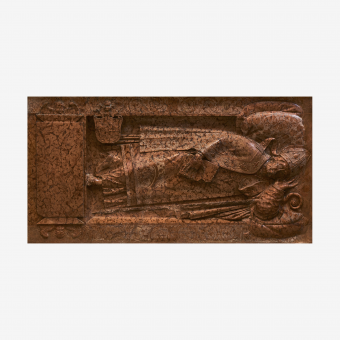
Built in the 15th century, the chapel belonged to the Goštautas (Gasztold) noble family, who are buried in the crypt below.
Two valuable 16th century tombstones have survived in the east and west walls of the chapel. The first is dedicated to Albertus Goštautas, the chancellor of the Grand Duchy of Lithuania (by Bernardo Zanobi da Gianotti). This is the oldest memorial sculpture in Lithuania. The influence of both Gothic and Renaissance art forms are obvious. The second tombstone is dedicated to Bishop Paulius (Povilas) Alšėniškis (Pawel Holszański) (by Giovanni Maria Padovano).






Albertus Goštautas (1480–1539) was the son of Martinus Goštautas and Anne, the duchess of Alšėnai. He became chancellor of the Grand Duchy of Lithuania and voivode of Vilnius, and was called ‘the Viceroy of Lithuania’ due to his political influence in the first half of the 16th century. He paid much attention to the chapel, and was one of the first well-educated Lithuanian nobles to make impressive endowments to commemorate his family. The extravagant red marble monument erected after Albertus Goštautas’ death was most likely commissioned by his son Stanislaus, the first husband of Queen Barbara Radvilaitė (Radziwiłł). The Goštautas line ended with his death, and the monument remained unfinished: only a tombstone plaque has survived, with a relief image of the noble in Renaissance armour holding a sword and a banner.
The plaque was partly destroyed during the wars of the mid-17th century, but it still preserves the features of Albertus Goštautas, one of Lithuania’s most prominent nobles, and his coat of arms, which combines the crests of his father, his mother, and both grandparents. The surviving tombstone plaque of Albertus Goštautas in relief, with features of Gothic and Renaissance art, is the earliest work of memorial sculpture in Lithuania.

Since 1989 this chapel has been dedicated to the memory of the killed, imprisoned or exiled during the Soviet era. The chapel has three inscriptions commemorating Bishops of Vilnius: Bishop Jan Nepomucen Kossakowski (1755–1808), Bishop Mečislovas Reinys (1884–1953), and Bishop Julijonas Steponavičius (1911–1991).The niches in the walls contain eight sculptures of saints, above which little angels hold symbols of the virtues (work of Pranciškus Smuglevičius). The sculpture of the Crucified Christ was transferred to the chapel from the Church of the Trinitarians, which was closed in 1864.



The Royal, or Wołłowicz, Chapel was built in the late 15th century by the King of Poland and Grand Duke of Lithuania Casimir Jagiellon. The crypt of this chapel became the burial place for members of the royal family, including the famously pious Prince Casimir.
When the Church allowed the veneration of St Casimir, Sigismund III Vasa, the ruler of Lithuania and Poland, began to build a new Chapel of St Casimir in the southeast corner, on the site of the former chapel maintained by the Bishop of Vilnius Eustachius Wołłowicz (1572–1630). The two chapels swapped places, and the Royal Chapel became the Wołłowicz Chapel. The chapel was built and decorated by Eustachius Wołłowicz before 1630.
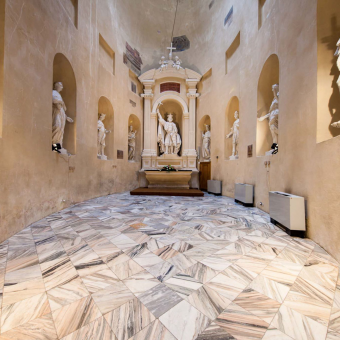
St Vladislaus was the king of Hungary and Croatia who lived in the 11th century and became the patron saint of Hungary. Jogaila, the ruler of Lithuania and Poland, chose Vladislaus as his baptismal name. That is why when Jogaila built Vilnius Cathedral in 1387 it was decided to name it after both St Stanislaus and St Vladislaus.
Wawrzyniec Gucewicz designed the elliptical Chapel of St Ladislaus (formerly the Chapel of Bishop Abraham Woyna) in the last major remodelling of the cathedral. It used to have mural paintings, of which only fragments can be seen today. The Latin inscriptions that have survived beside the chapel’s altar reveal the theological meaning of the paintings: Zelus (zeal) and Fides (faith). The altar was built in the mid-19th century, and the niche holds a massive plaster sculpture of St Ladislaus holding a cross (1861–1863, by the sculptor Henryk Dmochowski). Until 1905, this sculpture was covered up, by order of the Imperial Russian authorities, as a manifestation of active Catholic missionary work. The chapel’s Latin dedication can be seen in the fresco above the statue of King Ladislaus.
At Christmas, a nativity scene is displayed in the Chapel of St Ladislaus, and a procession with the Blessed Sacrament is conducted to the chapel on Maundy Thursday.




Vilnius, 1535
With a weight of about 20 kg and a height of 150 cm, this is one of the largest monstrances in all Central Europe. The vessel, which has Late Gothic and Renaissance traits, is thought to be the work of an unknown goldsmith in Vilnius. One of the most prominent noblemen of the time, Albertas Goštautas, Chancellor of the Grand Duchy of Lithuania and Voivode of Vilnius, originally gave this monstrance of remarkable size and artistic value as a gift to the Church of St Nicholas in the town of Geranainys. Numerous ornamental figures adorn the liturgical vessel. The photograph shows a small sculpture of St Adalbert (Voitecus), the patron saint of the founder. The other side depicts St Nicholas, the patron of the church in Geranainys. The Blessed Sacrament would be placed in the center of the monstrance. Above it there is an image of the Blessed Virgin Mary and Child, higher up there is Christ pointing to his wounds, and the very top is crowned with the scene of the Crucifixion. Under the glory the heraldic mark of the Goštautas family is incorporated, above which the year of the monstrance creation is engraved. The symbols of the four Evangelists are incorporated into the base of the monstrance.

The Chapel of St Casimir is a particularly holy site in Vilnius Cathedral, and a special chapel that continues to attract tourists and pilgrims. Casimir (1458–1484) was the second son of Grand Duke Casimir of Lithuania (ruled 1440–1492). He achieved fame both for his ruling skills and for his pious way of life. He died very young, and was buried in Vilnius Cathedral, where believers soon started to witness various miracles. The canonisation process started not long after his death, but it remained unfinished throughout the 16th century. The prince was officially acknowledged as a saint in the early 17th century, a fact celebrated with huge festivities in Vilnius in 1604.
The present chapel was built in 1623–1636, at the initiative of Sigismund III Vasa, the grandson of St Casimir’s brother, and the great grandson Ladislaus IV Vasa. It was designed and built by the Italian architects Matteo Castello and Costante Tencalla. The chapel was the first building in the Grand Duchy of Lithuania to be decorated mainly with marble. Its exterior was embellished with slabs of sandstone, which were rare here. The prince’s remains were transferred to the chapel in 1636. In the late 17th century, the dome and the altar were adorned with magnificent works of stucco.



The paintings of the Twelve Apostles on the pillars of the central nave are by Franciszek Smuglewicz.
The artist Costantino Villani was invited from Italy to create 16 large paintings specifically for the cathedral. It is the most spectacular series of paintings on themes from Holy Scripture in Lithuania.
Facing the altar, scenes from the New Testament are depicted on the left side, and scenes from the Old Testament are depicted on the right.
On the right side, eight paintings representing stories from the Old Testament hang on the walls above the chapels between the pilasters. Walking from St Casimir’s Chapel towards the organ loft, they are: The Creation, Cain and Abel, Abraham’s Sacrifice of Isaac, Jacob’s Dream, Joseph in Prison, Moses at Mount Sinai, Joshua’s Victory and The Judgement of Solomon.
There are another eight paintings by Costantino Villani on the left side. Walking from the sacristy towards the organ loft, they are: The Annunciation by the Archangel Gabriel, The Nativity of Christ, The Massacre of the Innocents, The Adoration of the Magi, The Flight into Egypt, The Baptism of Christ, Jesus is Laid in the Tomb and The Descent of the Holy Spirit.

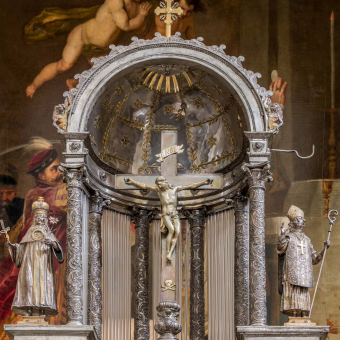
The altarpiece of the Cathedral Basilica’s main altar has three parts. The first, somewhat higher up than the others, bears a symbol of Divine Providence, above which there rises a cross with the figure of Christ. The second part features an elaborate tabernacle.
A tabernacle is an ornate box meant to hold the Most Blessed Sacrament. The Cathedral tabernacle was decorated with the scenes portraying the events of Holy Thursday: the Last Supper, Jesus washing the feet of his disciples, and his prayer in the Garden of Olives. Above the tabernacle there is a domed niche for a cross or a monstrance, beside which there are the statues of St. Casimir and St. Stanislaus – the patron saints of Lithuania and the diocese of Vilnius.
The new altar, where Holy Mass is now celebrated, was installed in 2007 in line with the indications of Vatican Council II.


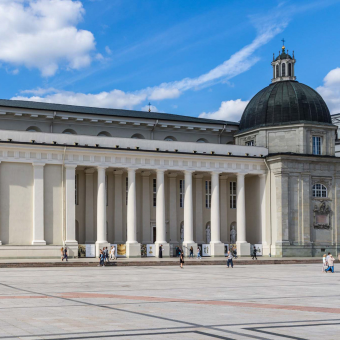




The Church of St. Michael the Archangel is the first sanctuary in Lithuania built as a mausoleum for a noble family. There are five burial crypts beneath the floor of the church. In some of them nuns were buried, in others were laymen. Leonas Sapiega, his sons Jonas Stanislovas and Kristupas and other family members were buried in the family crypt. The Czarist Russian army, which took Vilnius in 1655, ravaged, burned and plundered the city slaughtering thousands of people. The Cossacks murdered the nuns and the city residents who were hiding in the convent, they also looted the church and the vault with the Sapiega graves. Taking the expensive coffins and burial clothes, they threw the remains in the street.
Four early 17th-century burial monuments for the members of the Sapiega family have survived in the church and are of great value. They show the power, wealth and subtle artistic taste of those who commissioned them.


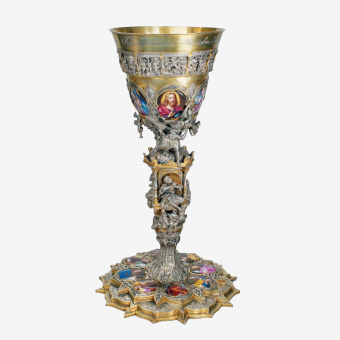
Western Europe, prior to 1854
This chalice is thought to have been created not for liturgical use but as a work of art to express an unconventional interpretation of traditional Byzantine iconography. Scenes from the life of Christ are cast on the chalice. It has enamel paintings of the Savior, the Blessed Virgin Mary, St Mary Magdalene and the Apostles. It also incorporates elements that are unusual in religious art: the allegories “Children’s Love for Parents” and “Grief with the Emblem of Death”, and the image of Satan crushed with the Blood of Christ. It was the famous collector Count Mykolas Tiškevičius of Biržai who donated the chalice to Vilnius Cathedral.



Palestine (?), 18th c.
Flower motifs, angel heads and figures of saints are carved on this Baroque cross. Below the cross, the scenes of the Annunciation to the Blessed Virgin Mary, St Anthony of Padua vision and Mary’s Visit to Elizabeth are depicted. The mark of Jerusalem cross suggests the work was created in Franciscan monastery workshops in the Holy Land and brought to Lithuania by an unknown pilgrim.

Vilnius, 1705-1712
In about 1705 Vilnius Cathedral acquired a relic belonging to Josephat Kuncevičius, who was the Greek Catholic archbishop of Polotsk. The reliquary in the form of a sarcophagus was commissioned specially for it. The vessel is decorated with acanthus leaves and crowned with the Greek Catholic archbishop’s miter. Until World War II, the reliquary was carried in annual processions on the feast of St Josephat.

The church of Trakai was not damaged during World War II, but it was decided to hide the most important valuables from its treasury. The most valuable items were buried inside the church. Among them was the great monstrance and golden crowns of Mother of God painting. The hiding place was opened in 1975 during the renovation of the church. A part of Trakai chuch treasure is now preserved in the Church Heritage Museum.
The painting of the Blessed Virgin Mary is one of the earliest and most venerated images in Lithuania. The legend says it was a gift from Byzantine emperor to Vytautas, the Grand Duke of Lithuania. Accounts of special graces and miracles associated with the painting date back to the beginning of the 17th century.

Johann Larry, Vilnius, 1751
This earliest rococo monstrance in Lithuania recalls another one which was made somewhat earlier in Augsburg and is kept in Vilnius Cathedral. The craftsman incorporated ornaments that believers donated as votive offerings to Trakai Mother of God.



Wolfgang Caspar Kolb, Augsburg, 1691-1695
This heavily ornamented Baroque monstrance bears the marks of the city of Augsburg and the initials of one of the best-known guilds of the time. Samogitian Bishop Kazimieras Pacas may have donated the valuable art work to Vilnius Cathedral. The iconography of the monstrance tells of Christ Passion and self-sacrifice for love of mankind. Two small angels with the instruments of Christ Passion are depicted on the sides of the monstrance. The left angel holds the cross and a hammer, while the right one holds the ladder and pincers that were needed to remove Jesus body from the cross. Above the heart-shaped receptacle for holding the Blessed Sacrament, a pelican is depicted sitting in its nest. This bird was said to cut open its breast in times of famine and feed its young with its blood. The pelican thus became the symbol of Christ sacrifice for love of mankind.

Augsburg, 1691-1695
The chalice with intricate enamel painting depicts the scenes from Christ Passion: the Last Supper, the Agony in the Garden, the Betrayal, the Flagellation, the Ecce Homo, and Christ before Caiaphas. The vessel represents the highly advanced German school of goldsmithery, which was fond of lush forms and colourful décor.

France (?), the 2nd half of 14th c.
It is the oldest Gothic plastic artwork in Lithuania. Four Gospel scenes are carved in ivory: the Birth of Christ, the Adoration of the Magi, the Crucifixion, and the Laying in the Tomb. Similar works were created in Byzantium in early Christian times, but from the 9th century France became a hub for this type of art.
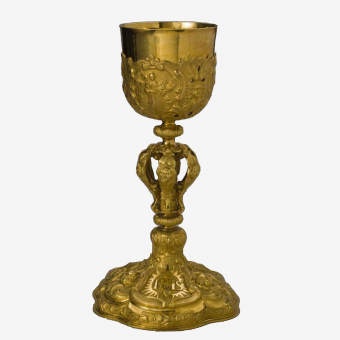
Andrzej Mackensen I, Gdansk, c. 1646
This pure gold chalice is the largest in Lithuania. It is masterfully crafted with artistic ornamentation and a rare composition of the base with an openwork knob. St Francis of Assisi, St Anthony of Padua, St Bonaventure, St Casimir and St Stanislaus are depicted on the chalice. The chalice also has a great memorial value – according to one of the versions, the golden chalice was donated to the Church of the Friars Minor of Druja by the endower of the church, the famous patron and supporter of the Catholic Church Kazimieras Leonas Sapiega. The Sapiega's coat-of-arms is represented on the foot of the vessel.

Vilnius, 1582-1583
This uniquely shaped chalice is richly decorated with Renaissance artistic ornaments and figures of saints. Its unusually abrupt base bears images of the Savior and the twelve Apostles, while the cup has images of the four Evangelists. It is guessed that the chalice was donated to the jesuit Church of St. James in Riga by the Bishop of Vilnius and later Krakow, Cardinal and Count Jurgis Radvila on the occasion of the ordination of its priest in 1583. In 1612, while retreating from Riga, the Jesuits took the chalice to the Church of St. Ignatius in Vilnius, and after the liquidation of the Jesuit order, the vessel was transferred to the Carmelite Church of St. George; in the 19th century, the bishop assigned it to the Vilnius Cathderal.

Vilnius, c. 1728-1735
Bishop Bogusław Korwin Gosiewski of Smolensk donated this small statue of St Stanislaus to Vilnius Cathedral. In 1815, the work together with some other valuable items was stolen. In the early 19th century it was regained and adapted to become a decoration of the main altar.

Vilnius, 1637
The noble Gosievskis family gave this statuette with relics of the saint to Jesuit Church of St Casimir in Vilnius. In the early 19th century, after the Jesuit order was suppressed and the church made into a parish, the reliquary was moved to the altar in Vilnius Cathedral. A matching figure of bishop St Stanislaus was added, as during Polish-Lithuanian Commonwealth these saints were typically shown together as the patrons of the two states.


Cross – Vilnius (?), 1530-1539; crystal parts – Venice, c. 1300; base – Vilnius, after 1836
Count Albertas Goštautas of Geranainys left this cross with relics of St. Eustachius to Vilnius Cathedral in his will. The person who crafted the reliquary was an excellent Renaissance-era artist. The crystal cross and large gemstones below it are thought to be older; works of similar form, following Byzantine jeweller’s art specimens, were made in Venice in the second half of the 13th century. In the center of the reliquary there is a structure that joins the crystal bars and a gilded silver image of Crucified Christ. The metal crosspieces are decorated with a Renaissance vine motif and, following the fashion of the time, with the images of Roman emperors.


Vilnius (?), 1649-1655
One of the most valuable vessels in the cathedral treasury was a gift from Vilnius Bishop Jurgis Tiškevičius. The monstrance is remarkable for its highly colorful use of enamel, which is rare in Lithuania, as well as its combination of gold and precious stones in an impressive arrangement that tells of the mysteries of God’s love and redemptive sacrifice. A small figure of the Savior’s Mother, the Blessed Virgin Mary, has an important place in the overall composition.

Augsburg (?), Munich (?), late 15th-early 16th c.
This plaque was donated to Vilnius Cathedral in 1817 by a famous Lithuanian educator and philanthropist Count Povilas Ksaveras Bžostovskis. Previously it may have been a part of a small altar for personal piety, which the count brought back from travels in Europe. The composition of the relief of the plaquette and the rendering of the figures is typical of early Renaissance of Central Europe, though the influence of Italian art of that period can also be noticed. It is set in a Classicist frame adapted for the image in the early 19th century.
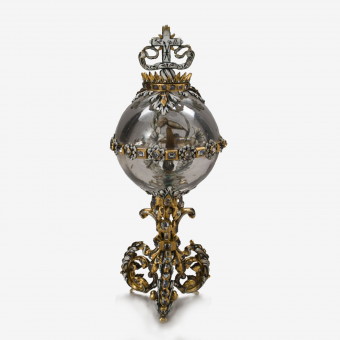

Florence, 17th c.
This masterpiece of jeweller’s art, embellished with enamel and diamonds, fascinates with its subtle forms and elegance. The reliquary belonged to Vilnius Bishop Mikalojus Steponas Pacas and after his death it was given to Vilnius Cathedral. The Pacas family of Lithuanian nobility traced their origins to the Pazzi noble family of Florence and spread devotion to the holy “kinswoman” in Lithuania.

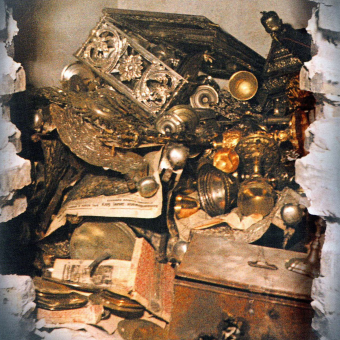
The Vilnius Cathedral Treasury is the oldest and most extensive of all the treasuries preserved in Lithuanian churches. The first items it acquired were rich liturgical articles donated by Jogaila and Vytautas of the Gediminid dynasty and their wives, along with gifts from abroad sent to celebrate Lithuania’s official adoption of Christianity. Heads of state, nobility and bishops bestowed magnificent liturgical articles on the Cathedral: these were crosses, chalices, reliquaries, monstrances. In wartime the valuables were removed or hidden, the last time it happened when World War II began. On the eve of World War II, the contents of the Vilnius Cathedral treasury were hidden in a wall and bricked over. The treasure was discovered in 1985, but was not shown to the public until 1999-2003 exhibitions at the Lithuanian Art Museum. In 2006, the entire Cathedral treasury was returned to Vilnius Archdiocese, and since 2009 it has been on display at the Church Heritage Museum.
Discovery of Vilnius Cathedral treasury. Photo by R. Budrys, 1985, Lithuanian National Museum of Art


Since 2019, new routes are open to visitors at the crypts of Vilnius Cathedral in the northern part of the cathedral provide an opportunity for visitors to learn about and see spaces that for years had been literally inaccessible, bricked up and closed off. Visitors taking the extreme tour will be able to see some of the oldest masonry in Lithuania, remains of a 13th-14th century tower and staircase, invaluable historic masonry of Jogaila and Vytautas’s cathedral, crypts and mausoleum that harken back to numerous different burial customs, walls that evidence the cathedral’s reconstruction, , an 18th century drainage system, Gothic bricks and other valuable items arranged over a rather large area of 120 square meters under Vilnius Cathedral.
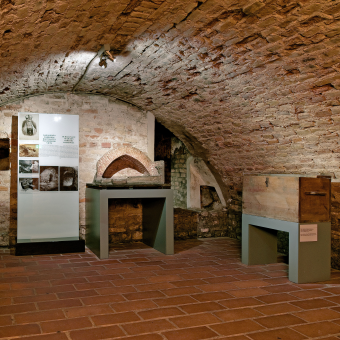
For many centuries the crypts beneath the cathedral were used to bury prominent nobility, rulers, bishops and Chapter members of the Grand Duchy of Lithuania. The most famous of them were Vytautas the Great, Alexander I Jagiellon, and Barbara Radziwiłł. The historic walls of the Cathedral, crypts, and one of the oldest frescos in Lithuania can be seen in the underground exhibition.

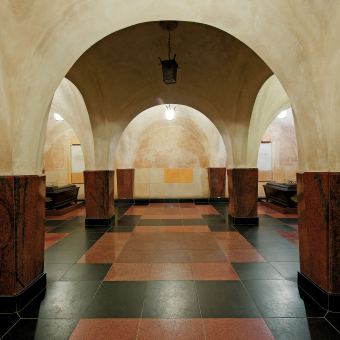




Vytautas was the first ruler of Lithuania to be buried in Vilnius Cathedral. He contributed to the reconstruction and decoration of the church.1930 was the year when 500 years since Vytautas death was commemorated. It was hoped that by the time the remains of the grand duke would be recovered and transferred into the newly made sarcophagus. In fact, though, the search for Vytautas remains has not stopped yet.
Sarcophagus for the remains of Vytautas the Great. Czechoslovakia, 1930. National Museum of Lithuania



The Bell Tower is an important part of the complex comprising Vilnius Cathedral Basilica and the Lower and Upper Castles and the symbol of the city. The history of Bell Tower dates back to the middle of the 13th century. It acquired its current appearance in the early 19th century. The oldest clock in the city shows time in the upper part of the structure; the tolling of the bells invite people to Holy Mass, and an unexpected panoramic view of Vilnius opens out.
During the Soviet times a decision was made to install a carillon in the Cathedral Bell Tower. Bells of various sizes were brought here from closed churches in Lithuania. But despite drilling, milling and grinding, the efforts to tune the bells failed. In 2009 they were restored in the workshop of the Archdiocese of Cologne. Some of the bells have been returned to the churches from which they were taken, others are on display in the Bell Tower.
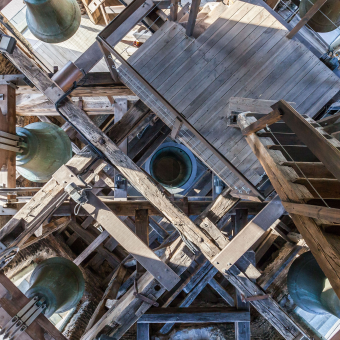


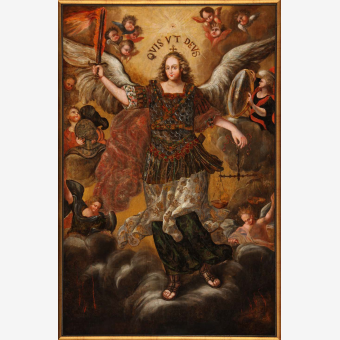
Vilnius, c. 1691
This painting was made for Bernardine Franciscan Sisters Church of St Michael the Archangel. The Archangel is portrayed as leader of the heavenly host who battles the forces of evil with a fiery sword. His left hand holds a scale to implement justice on the day of Final Judgement. The Latin inscription gives Hebrew meaning of the name Michael: “Who is like God”.

The sacristy is a place for clergy to vest and for storing the items needed for liturgical use. At present the church sacristy contains an exhibit of liturgical vestments.
At all times and in all religions, liturgical vestments sought to distinguish a clergyman among other believers, as if emphasizing the significance and nobility of religious ceremony. The forms of the vestments used in the liturgy of the Catholic church were mainly inherited from the classical tradition, and their purpose was finally established in the Middle Ages; in the newest times it changed very insignificantly and did not adapt itself to the rapidly changing secular fashions. Only some minor details of the vestment, the types or patterns of textiles did change. Vestments of clergymen were made of expensive textiles: silk, velvet, bombast, brocade, damask, also finest wool or canvas. Most often they adorned with lace, appliqué, embroidered in silk, gold and silver, and decorate with frills and galloons.



Jonas Stanislovas Sapiega’s (1588–1635) burial monument is incorporated into the portal of the door to the sacristy. This arrangement, which is extremely rare in Lithuania, symbolized the passage from the world of the living to that of the dead, from temporal life to eternal one.

The monument to Kazimieras Leonas Sapiega’s wife Teodora Kristina (†1652) stands out for its lavishness and elegance. The woman, who was famous for her beauty, is depicted with the 17th century hairstyle and clothing. The star and crescent at the top symbolize the Tarnovskis family victories in battles with the Turks.






Vilnius, late 17th c. - 1701
These sculptures were originally made for the main altar of Saints Peter and Paul Church in Vilnius. They expressively depict the Apostles, the Evangelists and characters symbolizing various nations. It is thought that the arrangement was meant to tell of the descent of the Holy Spirit, described in the Acts of the Apostles, at the time when Christ disciples spoke to people gathered from the whole world in their native languages.

While walking around Vilnius, one cannot but notice the Christian monasteries that are integral to the city’s landscape. Monastic communities have played an immanent role in the city's existence, in part, forming the backbone of its very identity. The monks who settled here and the nuns, who followed soon after, never abandoned Vilnius. As historical trends ebbed and flowed, some more favourable to the monastic communities than others, and as the initial grand dukes, kings, governors, military leaders, first secretaries, presidents, burgomasters, and mayors were replaced by new ones, the monks and the nuns always remained. Not only were they unintimidated by wars, revolutions, and uprisings, they even resisted repression and occupation. Even when they became unnoticeable, the brothers and sisters of the now dispersed communities would not renounce the landscape of their Heavenly City, which was something they loved and cared for, and for which they remained faithful to their calling.

1403
Tertius Ordo Regularis Sancti Francisci Assisiensis / The Third Order Regular of St Francis
The Bernardine nuns were a community founded by the laywomen of the Franciscan Third Order Regular. They were brought together in Italy by Blessed Angelina of Marsciano. The women, dedicated as they were to the monastic life, lived in a community but retained relative independence, and owned property. They took the vows of obedience and chastity but were not bound by the rule and enclosure until 1566, when Pope Pius V announced mandatory enclosure in all female monasteries.

Vilnius, 1775
Oil on canvas
The Franciscan and Bernardine religious orders fostered great devotion to the mother of the Blessed Virgin Mary, St Anne. The Vilnius Bernardine Church of St Michael the Archangel contained an altar dedicated to St Anne from the very beginning – endowed by the benefactor, Leo Sapieha. The altar was renovated several times using the funds of the convent itself and its devout benefactors, and the image that it contained was also replaced. The picture from the Church of St Michael the Archangel that ended up at the church in Naujasis Daugėliškis, was painted in 1775 by the same artist who created the image of St Clare of Assisi.

Vilnius, late 17th century
Linen canvas, fabric scraps, silk gilded silver and silver threads and cords, embroidering; flesh tints – oil on canvas, painting
An important occupation of the Bernardine nuns was the embroidery of liturgical vestments and other church fabrics, which was underlined in the Bernardine convent registers of 1671–1775 as a praiseworthy activity that made them stand out in the community. The long-living Otylia Lewoszówna, who came to the Convent of St Michael the Archangel together with the first nuns from Užupis, and even at the age of 60 continued to embroider veils, humeral veils, altar frontals, and chasubles for the church, is mentioned among the embroiderers. In the first half of the 17th century, Melania Plonska who was accepted into the Convent of St Michael without a dowry, but later bought a silver helmet for the painting of St Michael and installed a little altar of Our Lady of Assumption, embroidered in gold a great many veils and other fabrics. Franciszka Zienkiewiczówna is also recorded as having had extraordinary abilities. With their handiwork, the nuns above all enriched the collection of liturgical textiles of their own church, but one can assume that they also shared their works with other convents, monasteries, and churches.

Vilnius, after 1785
Wood, joiner’s and carver’s work, gilding; glass, silk, velvet, metal (silver?)
The wooden aedicula-shaped glass reliquary contains a skull placed on a pillow. In the background, three smaller reliquaries of saints with inscriptions are attached to the red fabric. Under the pillow, two documents were found testifying that the relic of the head of St Felicissimus, had been extracted from the catacombs in Rome, and in 1676 was gifted to the Provincial of Poland Minor and Lithuania, Gabriel Rotermund. On 17 December 1676, its authenticity was confirmed by the administrator of the Vilnius Diocese, Mikołaj Stefan Pac, who allowed public veneration of the relic. On the same day, the provincial handed over the relic to the Church of St Michael the Archangel in Vilnius. The second document issued in 1777 to the Bernardine monk, Jan Nepomucen Pacewicz, testifies to the authenticity of the relics of the holy martyrs Urban, Jucundus, Pius, and Casta, extracted from the Priscilla catacombs in Rome. In the postscript, it is asserted that their authenticity was confirmed by the Bishop of Vilnius, Ignacy Jakub Massalski, on 15 May 1786. Most probably at that time, all five relics were placed together in the wooden reliquary. The relic of the head of St Felicissimus, gifted by Gabriel Rotermund, is mentioned in the documents of the Bernardine nuns among the treasures that pertained to the painting of the Blessed Virgin Mary as early as 1678. At that time, it was placed in a specially manufactured reliquary decorated with silver.

Vilnius, 1706
Silver: copper alloy (details): forging, casting, chiselling, punching, cutting, gilding
The ciborium, which today is kept in the church at Palūšė, originally belonged to the Vilnius community of Bernardine nuns. This is confirmed by a Latin inscription engraved on its base, stating that in 1706, the Mother Superior, Antanina Žabaitė, procured the vessel for the Vilnius Convent of St Michael the Archangel. Historical sources indicate that thanks to her efforts, besides carrying out other important work such as church reconstruction and the consolidation of pious devotions, a silver casing for the painting of the Blessed Virgin Mary was acquired, along with silver candlesticks, a chandelier, and a large monstrance-shaped reliquary. The church also acquired some liturgical vestments and embroidered antependia (altar frontal).

16th c. – 17th c.
Glazed clay. Lithuanian National Museum
The convent buildings were heated by various means, such as tile and hypocaust stoves. The former palace of Eustachijus Valavičius, where the first nuns took residence, was already equipped with tile stoves decorated with coloured glazed tiles. The stove doubled as an interior decoration. The uniqueness of the kiln stemmed from the proportions of its various parts, combinations of tiles and other details: cornices, friezes, crowns. Locally made ornate tiles featured reliefs and would often use green, blue, or yellow glaze. The decorative patterns of the tile panels varied from geometric to floral, to figurative and could be both religious and secular in content.
A hypocaust stove discovered in the convent’s cellar under the refectory, was built in the middle or the second half of the 17th century. When the stove was heated, hot air would circulate through canals and thus heat several rooms. Its mouth was installed on the outside of the building.

Vilnius, 17th–early 18th century
Oil on canvas
The painting of St Francis discovered at the church in Naujasis Daugėliškis, was probably meant to hang in the convent premises. It represents the vision of St Francis while praying in preparation for the Feast of the Exaltation of the Holy Cross in 1224 at the monastery of La Verna. St Francis saw a vision of the Crucified Christ in the shape of a six-winged seraph and the marks of Christ’s torture were imprinted on his body. The inscription at the bottom features lines from a hymn sung during the Feast of the Stigmata of St Francis: You have sealed, oh Lord, your servant Francis, with the signs of our redemption.

1216
Ordo Praedicatorum / Order of Preachers
St Dominic (1170–1221) called for the gospel to be taught through peaceful preaching and discussions among people rather than armed crusades. The Dominicans, famous for their intellectualism, initially settled in larger university cities and eventually became a strong force of re-evangelisation throughout the Christian world.
In 1501, the Grand Duke of Lithuania, Alexander Jagiellon, granted an endowment to the Church of the Holy Spirit in Vilnius, and gave it to the Dominicans who are thought to have arrived in Vilnius during the 14th century. The Vilnius Monastery of the Holy Spirit became the central and largest Dominican monastery in the Grand Duchy of Lithuania. It was home to 60 monks rising to 116 in 1748. It housed a novitiate, a house of studies and a library containing in excess of 5,000 books. In 1642, the second Dominican monastery in Vilnius was established in the Lukiškės suburb; its endower was Castellan of Smolensk, Jerzy Littawor Chreptowicz. The Monastery of the Apostles, Philip, and James, in Lukiškės soon earned fame for its miraculous painting of the Mother of God, which is still located in the church to this day. The third Dominican monastery in present day Vilnius was founded in Verkiai. It was from here that in 1664, the then Bishop of Vilnius, Jerzy Biallozor, initiated the founding of the Calvary as a tribute to the country’s liberation after the war with Moscow. It was finished in 1669. It survived until the Soviet order for its desecration was issued in 1963. It was rebuilt after Lithuania regained her independence. After the partition of the Polish-Lithuanian Commonwealth, the Dominicans of Vilnius were subject to repressions by the Tsarist authorities. The Monastery of the Holy Spirit was closed in 1844, and its premises housed various offices. The adjoining church was given over to parish use. The Order of Preachers returned to Lithuania in 1992 and took back into their care the monastery and church of Saints Philip and James.

Lithuania, 2nd half of the 17th c. (embroidery, painting), 19th c. (fabric, sewing)
On the back of the dalmatic, beside the floral motifs and adoring angels, there are two compositions symbolising the Dominican devotion to the Holy Rosary. At the top, there is an embroidered symbol reflecting the Holy Name of Jesus, because in addition to the universally popular prayer of the Rosary to the Blessed Virgin Mary, the Dominicans also popularised the rosary of the Holy Name of Jesus. The bottoms of the dalmatics depict a traditional scene – the Mother of God handing a rosary to St Dominic. However, there is a unique feature that can be seen because depicted on the right side, is not St Catherine of Siena but St Hyacinth (declared the patron of Lithuanian in 1686), while St Catherine is instead embroidered on the front of the dalmatics.


Paintings – Vilnius, 1771, altar – Vilnius, 1819–1830, angels – Vilnius, late 17 – early 18th c.
The processional altar belonged to the church of the Convent of the Holy Spirit in Vilnius. The Fraternity of the Rosary had been active since the 16th century and traditionally kept two altars dedicated to the Blessed Virgin Mary Rosary and the Holy Name of Jesus. The processional altar has images that match the titles of the altars in the church: on one side – the scene where a rosary is being given to St Dominic and St Catherine of Siena, and on the other – a composition symbolising the Holy Name of Jesus with the Infant Jesus above the initials IHS. At the bottom of the painting of the Holy Name of Jesus, it says that it was acquired on 1 October 1771 under the care of Father Marcelijus Gumkovskis. According to written sources, Fr. Gumkovskis, who was born in 1730, joined the Dominican monastery in 1754 and held the office of the Preacher General at the Lukiškės Monastery, and later at other provincial monasteries. In 1771, he may have held the office of the Preacher General and Rosary promoter at the Monastery of the Holy Spirit. By his request, a rococo style painting by a professional painter was most likely used to adorn the processional altar at the time, and was moved to a new tin-covered retable in the first half of the 19th century.
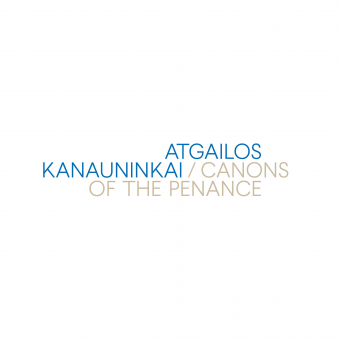
2nd half of the 13th c.
Ordo Canonicorum Regularium S. Mariae de Metro de Urbe de Poenitentia Beatorum Martyrum / Canons Regular of the Penitence of the Blessed Martyrs
Canons Regular of the Penance were dedicated to parish pastoral care and lived according to the Rule of St Augustine. Their connection with the saint and ascetic practice was emphasised in the order’s sign – a red heart with a cross growing out of it, which they would wear on their white abbots.
The Canons Regular of the Penance of the Blessed Martyrs was the first Religious Order to settle in Lithuania after the country’s conversion to Christianity. Initially endowed by Jogaila in 1390-91, their monastery in Bistryčia remained their sole community for a long time. In the 17th century, a large number of new dwellings belonging to the Canons appeared in the Vilnius diocese, but they were mainly small residences kept by two or three monks who served in parish churches. At the end of the 18th and during the first half of the 19th century, chapters of the Canons Regular of the Penitence of the Blessed Martyrs of the Province of Lithuania most often assembled in the Užupis Monastery. However, the decline of the Order that began at that time, gradually caused a crisis within the Vilnius community. After the suppression of all the monasteries and residences of the Order in 1832; two former canons still remained to serve at the Užupis church for some time afterwards.
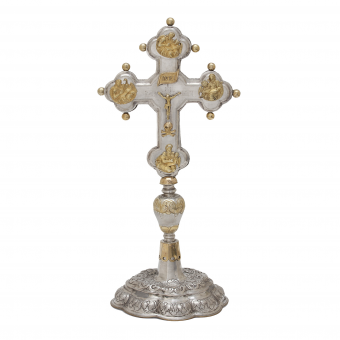


Vilnius (?), 4–5 decades of the 17th c., 19th c.
The base of the cross-shaped relic is decorated with heraldic symbols. Engraved on one side of the base is the emblem of the Order of the Canons Regular of the Penitence – a heart with a cross at the top. On the other side of the base is the donor’s quartered coat of arms with the initials "KW / IT".

1446
Congregatio Sanctissimi Salvatoris Cannonicorum Regularis Lateranensis / Canons Regular of the Congregation of the Most Holy Savior at the Lateran
In 11th to 12th century, canons of cathedral chapters united into communities that would own shared property and take monastic wows, and thus gave rise to a specific category of monks – the canons regular. One of such groups that used to service the Lateran Basilica was given the name Canons of the Lateran. Their goals include serving the divine cult, praying the Breviary prayers in unison, preaching sermons, parish apostle work, educating youths and missionary work.
The Bishop of Vilnius, Eustachy Wołłowicz settled the Canons Regular of the Lateran Basilica, who arrived in the city in 1625, in the suburb of Antakalnis. In 1638, the Canons were given the parochial church of St Peter’s in Antakalnis. At first, the financial situation was unstable, but after the Voivode of Mstislavl, Józef Korsak (1642), and Voivode of Vilnius and Grand Hetman of Lithuania, Michał Kazimierz Pac (1675), donated land for a monastery, life became a lot more stable. The latter benefactor built and impressively decorated the new brick church of Sts Peter and Paul, one of the masterpieces of Lithuanian Baroque architecture. During the 18th and the 19th centuries, the Antakalnis monastery accommodated up to twenty canons at different times and was the largest and most important community of the Canons Regular in Lithuania. The Canons dedicated themselves to the pastoral care of the people in this suburb of Vilnius. They delivered sermons in Lithuanian and Polish, taught at the parochial school, and took care of the almshouse. They led the Fraternities of the Five Wounds of Jesus and Our Lady of Grace. From 1653, the image of Our Lady of Grace was venerated in the church. This Vilnius community of Canons Regular was the last in the history of Lithuania to be suppressed by the Tsarist authorities in 1864. Three canons were accused of supporting the participants of the 1863 uprising and deported. One of them, Franciszek Zawadzki, later became a parish priest of the parochial Church of Sts Peter and Paul and unsuccessfully tried to revive the activity of the Canons of the Lateran. With the death of this priest in 1915, the almost 300-year-long history of this religious order in Lithuania came to a close.


Kempten, 1759. Metal decorations – Vilnius, 7th decade of the 18th c.
Luxuriously covered in velvet and artistically bolstered with metal on both sides, the two missals belong to the two brotherhoods of the Church of Saints Peter and Paul in Vilnius. The book containing the images of Antakalnis's Blessed Virgin Mary and St Augustine is mentioned in the list of assets owned by the brotherhood of Blessed Virgin Mary the Gracious, while the book with the symbols of the Wounds of the Saviour, and images of the holy apostles is included in the property list of the brotherhood of the Five Holy Wounds.


Vilnius, 1635
The chalice was procured in 1635 by Prepositus (Provost) Petras Smiarovskis for the community of Canons Regular of the Lateran Basilica, which had just recently settled in the Antakalnis suburb. The chalice, marked with an inscription noting his donation, is the oldest piece of heritage pertaining to the Canons Regular of the Lateran Basilica in Vilnius. Adding to the historical value of the piece is its artistic quality, while the abundant ornamentation and masterful metalwork showcase the high craftsmanship of Vilnius jewellers in the first part of the 17th century.


Vilnius, 1652
The chalice was donated to the church of the Canons Regular of the Lateran in Antakalnis in 1652 by the Prepositus Andrius Augustinas Kremeckis, which is evident from the rather heavy-handedly engraved text on the base of the chalice.

Vilnius, 1705 (?)
The ampulla paten is more recent and less well-made compared to the actual ampullas for which it was intended. The under side of the paten features a primitive embossed emblem of the Brotherhood of the Five Holy Wounds – the wounded, flaming heart of Christ along with his hands and feet that are marked by stigmata. The silver ampullas and the paten along with other religious wares and implements are all noted in the inventory of the Church of Saints Peter in Paul from 1782.
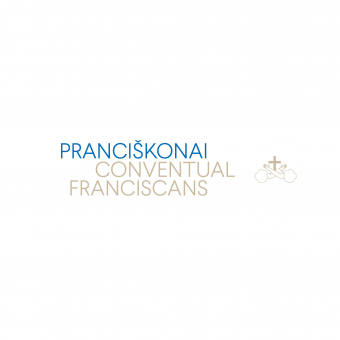
1209
Ordo Fratrum Minorum Conventualium / The Order of Friars Minor Conventual
St Francis was fascinated with the gospel and Christ, whom he wanted to follow in the way he had heard described in the invitation of the Gospel of Mathew at the chapel of Portiuncula – that is, to go and preach the Good News with no walking stick or shoes, no belt, and not even a spare shirt. His personal experience was where the history of one of the largest and most historically significant brotherhoods began.
The Franciscans had settled in Vilnius even before the country’s conversion to Christianity. The friar, Adolf, took part in the coronation of King Mindaugas in 1253. Two of the earliest churches of the Friars Minor Conventual in Vilnius, date back to pre-Christian times: the Gothic churches of St Nicholas of Myra, and the Assumption of the Blessed Virgin Mary. The latter church was where the earliest convent in Vilnius was founded. It was the most important monastery for the Friars Minor in the entire Franciscan Province of St Casimir, which itself was established in Lithuania in 1686. In 1864, when the Russian tsarist administration suppressed the monastery, the Friars Minor Conventuals were scattered and the church was desecrated. The friars returned to Vilnius in 1919 but their stay was interrupted by the Soviet Occupation in 1945 and the church was turned into an archive storage facility for a second time. In 1998, the church was returned to the Conventual Franciscans.

Vilnius, 1738
The Polish inscription on the base of the ciborium shows that the fraternity of Smoked Meat Producers (sausage makers) donated it on 24th February 1738. The producers of smoked meat had been working under the same guild as butchers. As required by the traditions of Vilnius guilds, these craftsmen had and took great care of the altar of the Immaculate Conception of the Virgin Mary at the church of the Assumption of the Blessed Virgin Mary.

1517
Ordo Fratrum Minorum / The Order of Friars Minor
Due to the important mission of pastoral care carried out by the Franciscans, in the 14th to 15th century, the strict poverty requirements that had been prescribed by their founder where officially lifted. Brothers who were following the orders of St Francis unconditionally found this to be unacceptable. One of the key reform movements in the 1st part of the 15th century was initiated by St Bernard of Siena and St John Capistrano. Their followers, the Observant Franciscans (known as “Bernardines” in Lithuania) where given the right of autonomy within the Franciscan Order in 1446, and in 1517 a new independent order was founded.
The first Franciscan Observants (Bernardines) in Poland settled in Krakow in 1453, on the initiative of St John of Capestrano and with support from King Casimir Jagiellon. In 1469, the ruler invited the Bernardines to Vilnius. A complex of Gothic buildings that rose at the Vilnia River at the turn of the 16th century comprising the Church of St Francis and St Bernardino, a convent and the Chapel of St Anne is one of the most spectacular late medieval ensembles of architecture and art in Lithuania. For almost four centuries, the Vilnius Bernardine convent was the most significant in Lithuania: it was the seat of the provincial, had a novitiate and a house of studies. The Vilnius Bernardines boasted one of the richest libraries in the entire province. In 1864, the Vilnius Bernardine Convent was suppressed. The convent’s buildings at first housed a garrison of the Russian army, and after World War I, the Art Faculty of Stephen Báthory University. The State Art Institute (today, the Vilnius Academy of Arts) has occupied the buildings since the end of the Second World War. The real owners returned to the neglected church in 1994.



Vilnius, late 15th c. – early 16th c., 2nd half of the16th c. – early 17th c., restored in 19th c.
The main monstrance kept at the Bernardine Church of St Francis of Assisi had always been considered to be a gift to the monastery by King Casimir Jagiellon (1427–1492), to celebrate its founding. However, there is some substantiated doubt regarding the period when it was made. The difference in style and form of separate parts suggests that the uniquely structured monstrance may have been created in the second half of the 16th century or early 17th century using the surviving parts of an earlier piece or earlier moulds. This may have happened after the fire of 1564 when the damaged Monastery of Observant Franciscans was being rebuilt, and which took several decades.
The Observant Franciscans of Vilnius treasured the monstrance. When the Russian army took over Vilnius in 1655 and temporarily made their home at the monastery, the monstrance and several other major valuable artefacts were buried in the garden, and as a result, they survived.
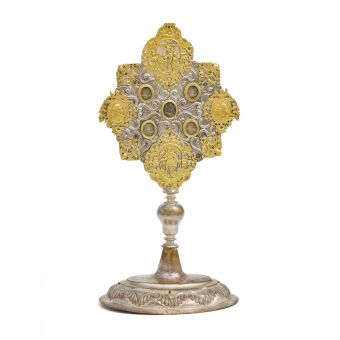
Vilnius, 17th c., 1st half of the 18th c., 1842
The reliquary kept in the Church of Mickūnai holds relics of St Vincent Ferrer, St Francis of Assisi, St Anthony of Padua, St Stanislaus Kostka and St Bartholomew. Documents attesting to the provenance of the three relics, signed in Rome in 1785, were found under a lid in its base. An inscription on the lid states they were enclosed on 1 October 1842. Upon evaluating the style of the reliquary, one can assume this was also the year when it was made. Silver baroque-style elements from various periods were uniquely used for its ornamentation. Judging from the shape, all the baroque details had been initially used in covers for liturgical books. The oldest among them, the winged angel heads, have been dated to the early 17th century. The reliefs at the top and bottom, which were created in the middle of the same century, are decorated with cartilage ornaments, and feature the Three Crosses and an image of St Florian, which is quite rare in Lithuanian art. Screwed onto the sides are medallions with the images of St Francis of Assisi and St Anthony of Padua in profiles that were cast in the first half of the 18th century.

1198
Ordo Sanctissimae Trinitatis et Captivorum / Order of the Most Holy Trinity and of the Captives
St John of Matha (1160–1213) and St Felix of Valois (1127–1212) founded the Trinitarian Order together during the era of the crusades. From the very beginning, the brotherhood, dedicated to the Holy Trinity, worked on the most outstanding mission – the ransom of Christians held captive by Muslims.
The Trinitarians were invited to Lithuania by the chief army commander, the Hetman of the Grand Duchy of Lithuania and Voivode of Vilnius, Kazimierz Jan Sapieha. In 1693, representatives of the “Spanish” reformed branch of the order arrived in Vilnius. From 1694 to 1696, a brick monastery was built. The Trinitarian Church of the Holy Redeemer, Jesus of Nazareth, was consecrated in 1716. The Antakalnis convent became the leading centre in the St Joachim Trinitarian Province of the Polish-Lithuanian Commonwealth established in 1726. The monastery also functioned as a house of studies for Trinitarian clerics. Their church won fame for a miraculous statue of Jesus of Nazareth. The Bishop of Vilnius, Konstanty Kazimierz Brzostowski, established the second Trinitarian monastery in 1700. He assigned land for the monastery in the vicinity of the Verkiai Palace that belonged to the bishops and he renamed the location as Trinapolis. That is where the Trinitarian novitiate of St Joachim’s Province was housed. The monastery was abolished in 1832. Its buildings were converted into garrisons and a hospital, and later given over to the Russian Orthodox Church. The monastery in Antakalnis survived the longest in the entire former province of St Joachim until 1864, when it was suppressed and began to serve the needs of the Russian army. The church was given to the Eastern Orthodox Church. The Trinitarians never returned to Lithuania.


Workshop of Fridrich Kwieczor, Vilnius, circa 1720–1722
There is some information that indicates that the famous Vilnius carver, Fryderik Kwieczor, created the altars and pulpit of the Trinapolis Church of the Holy Trinity from 1720 to 1722 at the request of Konstanty Kazimierz Brzostowski. After the monastery was closed and the church interior destroyed, some elements of the fittings, altars, paintings, and implements were distributed to other churches in the Vilnius Diocese. The peculiar angel figure is a characteristic symbol of the monastery's mission of rescuing prisoners. Its origin is related to St John of Matha‘s vision: Christ, who switched prisoners, appeared to him in the form of an angel. It is probable that the composition of the Angel of Redemption was intended for the pediment of the Church of Trinapolis.

1540
Societas Jesu / The Society of Jesus
Following the example of their founder St Ignatius (1491–1556), the Jesuits became guardians of the spiritual life of both clergy and laity. They were committed to serve wherever the church needed them, undertook to educate youths in schools and universities, and went on missions to non-Christian countries.
With the aim of strengthening the positions of the Catholic Church in the country at the peak of the Reformation, the Bishop of Vilnius, Walerian Protasewicz, invited the Jesuits to Vilnius. In 1569, several Jesuits from the Province of Austria arrived in the capital and after being given custody of the parish church of Saints John the Baptist and John the Evangelist, founded a college. In 1579, King Stephen Báthory and Pope Gregory XIII granted university rights to the Jesuit College. The college became an outstanding centre for education and boasted one of the richest libraries in the entire Grand Duchy of Lithuania as well as the most productive printing house in the country. The first dictionary of the Lithuanian language was published there as well as the first newspaper. An observatory was also built. In 1604, the House for Professed Jesuits was founded together with St Casimir’s Church. The novitiate was established alongside the church of St Ignatius of Loyola. The work of the Jesuits of the Lithuanian province (including Vilnius) which had its provincialate at St Casimir’s was cut short by the decree of Pope Clement XIV suppressing the Society of Jesus, in 1773. After World War I, Polish Jesuits settled at St Casimir’s Church, and after World War II, St Casimir’s Church was first converted into a warehouse for beverages, and later, into the Atheism Museum.
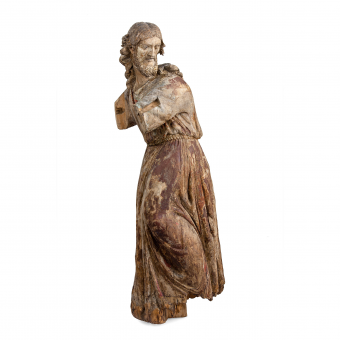
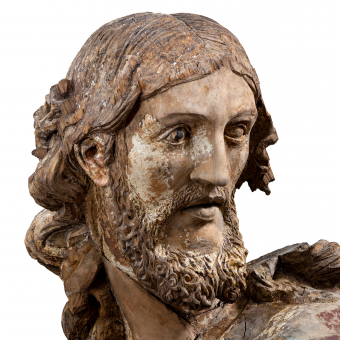
Vilnius, 1850
The Jesus of Šnipiškės is a figure of Christ that used to be located in a chapel in Vilnius near the Green Bridge. The Jesuits who erected it and took care of it wanted to remind Vilnius residents of the sacrifice of the monks of St Roch, who were all killed by the plague after staying back in the city to tend to the sick. The sculpture disappeared during the 1950s, when the chapel near the Green Bridge was destroyed under the orders of the Soviet authorities. In 2017, the figure of the cross-bearing Christ was unexpectedly found in the basement of the church of St Raphael. Although the piece has been damaged, it can be assumed that it is the famous image of the Jesus of Šnipiškės.

Vilnius (?), late 16th c. (after 1591) – early 17th c. (until 1621)
The ciborium was originally meant for the Church of St James (St Jacob) in Riga but when the Jesuits left there, it was brought to Vilnius. The fact that it belonged to the Riga church, now the cathedral, is confirmed by a unique decoration on the lid – a small figure of the apostle St James the Great symbolising the title of the church, standing under a renaissance-style canopy, with characteristic attributes: a book, a pilgrim walking stick, a flask and a hat adorned with a seashell. There are also three engravings of the three newly beatified Jesuits of that time – St Stanislaus Kostka, St Aloysius Gonzaga, and St Francis Xavier. The meanings encoded in the decorations of this magnificent ciborium are greatly complemented by the symbols on its eight-leafed base: the traditional Jesuit IHS emblem and the mythical bird, the Phoenix that symbolises Catholicism overcoming the Reformation in Livonia and rising again from the ashes.


Vilnius, 1703
The engraved German inscription states than the lamp was donated for the altar of the Brotherhood of St Martin in 1703. The Brotherhood was active in Vilnius at the Jesuit Church of St Ignatius and united German-born Catholics.

1256
Ordo (Eremitarum) S. Augustini / The Order of St Augustine (Hermits)
The brotherhood, based on the Rule of St Augustine, was founded by Pope Alexander IV, who decided to join several groups of hermits into a single community and create a new monastery dedicated to pastoral care in cities that would parallel Franciscans and Dominicans.
Augustinians became established in Lithuania during the time of Grand Duke Vytautas – the foundation of the first, and for a long time, the only convent in Brest is traditionally dated back to 1410. Despite their early settlement in Brest, several later attempts of Augustinians to expand their activity in Lithuania were unsuccessful. It was not until 1673 to 1675 that the second Augustinian community finally settled in Vilnius and became the second permanent base of the Augustinian Order in the Grand Duchy of Lithuania. Having recovered after the Great Plague, the Vilnius and Brest communities grew and flourished. In 1808, the Tsarist authorities took over their main building in Vilnius, but a new monastery was founded in Kaunas. It was returned to the Catholic Church in 1919, but the Augustinians did not return to Vilnius.

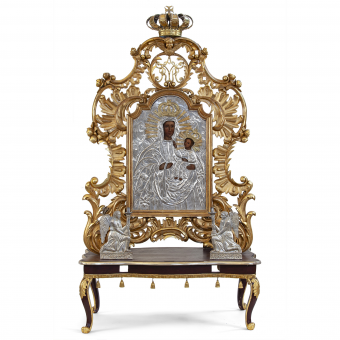
Vilnius, 2nd half of the 18th c. Angels – early 19th c.
The elegant cutwork rococo-styled processional altar used to belong to the church of the Augustinian Monastery in Vilnius. The paintings in its retable depict images that are particularly important to this monastery: on one side, a copy of the famous miraculous painting of the Blessed Virgin, Mother of Consolation that used to hang on the main altar of the church, and on the other, an image of the order’s most important saint, Augustine, Bishop of Hippo. St Augustine is depicted in a traditional manner, with clothing and insignia that are characteristic of being a bishop, holding up a burning heart in his hand symbolising the spirituality of the love of God. The landscape painted in the background is reminiscent of the legendary meeting between St Augustine and a child who was trying to scoop out the water from the sea with a seashell. The painting is adorned with a silvered embossed hammered metal cover, which depicts a leather belt in the hands of Mary – an element of the apparel of Augustinian monks, symbolising chastity.

Vilnius, early 18th c. (until 1731)
A commemorative inscription is engraved on the base of the chalice. It is unclear to which monastery – Vilnius, Brest or yet another – the Augustinian, Rokas Gonsovskis, named in the inscription had dedicated it to, but there is some information regarding him being elected the Provincial Superior of the Polish Province from 1734–1737, and taking control of it again from 1739–1740, when his successor unexpectedly died. The base of the chalice has an engraving of an angel holding the emblem of the Augustinians: an arrow-stricken flaming heart on a book.


Vilnius, middle of the 18th c.
The base of the chalice features an engraved Augustinian emblem supported by an angel: an arrow-stricken flaming heart on a book.

1617
Ordo S. Basilii Magni / The Order of St Basil the Great
The Rule of St Basil (329–379) is the basis of Eastern Christian monastic life. After the 1596 Union of Brest, it was applied to the Eastern Rite Catholic Monastic Order, which emerged in the Grand Duchy of Lithuania in the 17th century. The Basilians paired ascetic and contemplative life characteristic of orthodox monks with active missionary work and pastoral care that is typical of catholic monastic orders.
The Eastern Orthodox Church of the Holy Trinity rose on a hill in the civitas Ruthenica (Ruthenian city) in the eastern part of Vilnius back in the 14th century, but it is not known when the monastery was founded at this church. In 1514, in gratitude to God for the victory in the Battle of Orsha, Grand Hetman of Lithuania, Konstanty Ostrogski, built a brick Gothic church using a rectangular plan, and a monastery on the site. When the new Greek Catholic (Uniate) Church was established after the Union of Brest in 1596, this important hub of the Eastern Orthodox faith became a highly prominent centre of the new confession. The Order of St Basil the Great, or Basilians, became one of the key players in putting into practice the unity of the church. The Archimandrite of the Monastery of the Holy Trinity, and later, the Metropolitan of Kyiv, Joseph Benjamin Rutsky, fundamentally reformed monastic life in the Greek Catholic monasteries according to the model of Roman Catholic Religious Orders. His works were continued by the monk, Josaphat Kuntsevych, (he was martyred by the Eastern Orthodox believers in Polotsk in 1623 and was later officially acknowledged as the first martyred saint of the Greek Catholic Church). In 1617, the formerly autonomous communities of Uniate monks were united into the centralised Order of St Basil the Great, and the Basilian Province of the Holy Trinity was established, which was later divided into the Provinces of the Holy Trinity (Lithuania) and the Protection of the Mother of God (Poland) during the 18th century. The Basilians combined both the ascetic and contemplative characteristics of Eastern Orthodox monks with missionary and pastoral activity typical of Catholic Religious Orders. From 1628, a printing house operated at the Vilnius monastery, where Lithuanian publications were also printed. For some time after the partitions of the Polish-Lithuanian Commonwealth, the activity of Basilians remained unrestricted. However, in 1839, the church union was abolished and the Basilian monks and nuns of Vilnius formally converted to the Eastern Orthodox faith. In 1865, the Monastery of the Holy Trinity was officially closed. Later, with the change of regimes, the Church and the Monastery of the Holy Trinity changed hands, and in the Soviet period, the church was converted into a scientific laboratory. In 1994, the Basilians returned to their monastery.

1226
Ordo Fratrum Beatissimæ Virginis Mariæ de Monte Carmelo / The Order of the Friars of the Blessed Virgin Mary of Mount Carmel
The Carmelite brotherhood that was born in the Holy Land as a gathering of hermits, was fundamentally changed upon moving to Europe in the 13th century: it began to focus on communal life, settled in cities, engaged in pastoral care and studies and was labelled as a mendicant brotherhood in the 13th century.
Having reached Lithuania in the early 16th century, the Carmelite brethren were the third mendicant order to settle in Vilnius soon after the Dominicans. They built their residence outside the walls of the city of Vilnius, in the suburb of Puszkarnia, on the private estate of the Radziwiłł family. At the end of the period of the Reformation, which was not favourable to religious orders, the Carmelites in Lithuania, as in all of Catholic Europe, experienced a revival. In 1624, the second Carmelite monastery together with the Church of All Saints was founded in Vilnius. In 1687, the Carmelite monasteries in the territory of the Grand Duchy of Lithuania were divided between two provinces: those of Poland Minor–Lithuania and Rus’. All Carmelite monasteries that were in the present territory of Lithuania were assigned to the Province of Poland Minor–Lithuania, and only St George’s Convent in Vilnius became part of the Province of Rus’. The symbolic border of the provinces ran through Vilnius – the two Carmelite communities that operated there subsequently became central monasteries of different provinces (Lithuanian and Lithuanian-Russian). In their heyday (the mid-18th century), both monasteries had novitiates and organised studies for their future priests. The nineteenth century in Lithuania was fatal and tragic for this order. By the end of the century, not a single community had survived. In 1798, the monastery at St George’s Church was the first to be closed after the partitions of the state; its buildings were transferred to the seminary of the Vilnius Diocese. After the uprising of 1863, the Monastery of All Saints became a shelter for the members of various religious orders that had been closed down. In 1867, it was home to 17 Carmelites, 8 Trinitarians, 2 Dominicans and 2 Bernardines. The monastery was abolished in 1886. The Carmelite Order ceased to function in Lithuania. The fate of both of its churches in the Soviet period was similar: St George’s Church became a book storage facility, and the Church of All Saints was initially converted into a storage place, and later housed the permanent exhibition of the Folk Art Department of the Art Museum of Soviet Lithuania.

Vilnius, circa 1760–1765
The Carmelite Order tradition states that the first general of the Order, St Simon Stock, experienced a vision in 1251. He saw the Blessed Virgin Mary giving him a Carmelite scapular and promising to protect everyone who wears it until death, and to save them from the fires of Purgatory. An angel sitting at the bottom of the picture holds a banner with the inscription, Ecce Signum Salutis (“Behold, the sign of salvation”). The same words would usually be written on the smaller scapulars – the devotionalia, which the Carmelites would give out to the congregation.

Vilnius, 2nd half of the 18th c. (1760–1765?)
The entire Carmelite brotherhood held St Joseph in high regard. He was the earthly patron of Jesus Christ and husband of the Blessed Virgin Mary. Every church belonging to the Carmelite Order would make space for his altar, while the Church at St George’s Monastery in Vilnius had not just an altar but also a picture of St Joseph adorned with silver embossed covers in the first section of the retable. The top section of the retable had another painting depicting the saint – “The Engagement of Holy Virgin Mary and St Joseph”, which miraculously stayed in place even when the church had been converted into a book storage facility.


Vilnius, 1650
There is a very interesting inscription on the base of the chalice used at the Church of All Saints of the Carmelites of the Ancient Observance – it attests to the fact that the chalice of Our Lady of Mount Carmel was donated in 1650 by a beggar named Kasparas Miskelevičius, who had raised the money for it by begging. It is a unique instance where a person of the lowest of social rank has donated a silver chalice to the church. The Brotherhood of the Scapular was based in the Church of All Saints, and the chalice was most likely meant for its altar.

1593
Ordo Carmelitarum Discalceatorum / The Order of Discalced Carmelites
The aim to bring back the diminished component of contemplation and asceticism into the life of Carmelites became the main goal of the reform initiated by St Teresa of Avila. The basis of the new Carmelite way of life was following the lifestyle of the ancient order as well as enclosure and asceticism.
The Discalced Carmelites settled in Vilnius in 1624 having visited once before twenty years earlier. Within two years, they had already settled in a newly acquired house with a small chapel. The construction of a new early Baroque style brick church dedicated to St Teresa of Avila began in 1633, and the church was consecrated in 1654. When St Casimir’s Province of Lithuania was founded, the Vilnius monastery became the seat of the Provincial of the Discalced Carmelites of Lithuania. A novitiate and a house of studies was based there for a long time. The monastery had under its auspices the Chapel of Our Lady of Mercy of the Gate of Dawn, which remains a pilgrimage site to this day. The Discalced Carmelites also received significant support from the Lithuanian nobleman, Stefan Pac, and his wife Ona Marcibelė Rudaminaitė. Thanks to their efforts, in 1638, the Convent of Discalced Carmelites for Carmelite nuns with St Joseph’s Church, the only one in Lithuania and the richest in the Polish-Lithuanian Commonwealth, was founded nearby. In 1844, the Monastery of St Teresa of Avila was suppressed, and its premises were handed over to the Institute of the Daughters of Eastern Orthodox Priests. In 1865, the women’s Convent of St Joseph was closed, and the church was demolished in 1877. In 1930, the buildings belonging to the Monastery of St Theresa of Avila were returned to the Discalced Carmelites, but this hopeful period of restoration of this Religious Order was brutally cut short by World War II. The Church of St Teresa of Avila, having become a parish church, has never been closed.


Vilnius, 3rd q. of the 18th c.
Inside the rococo reliquaries, there are fragile compositions made of cut paper, glass and cloth intended to adorn the relics. Carmelite symbols appear on every container – a heart, a star and a mountain with a cross. The latter two motifs make up the emblem of the Discalced Carmelites – Mount Carmel with a cross and three stars symbolising the Blessed Virgin Mary and the prophets Elijah and Elisha. In the tradition of the Discalced Carmelites, the heart motif stands for the vision of St Teresa of Avila, where a seraph appeared to her and pierced the mystic’s heart with a golden arrow, filling it with the love of God. The nuns of St Joseph’s Convent in Vilnius might have decorated these reliquaries themselves. Discalced Carmelites were known for similar artistic endeavours using paper, silk, wax flowers, fruit and cutwork.

1633
Societas Filiarum Caritatis a S. Vincentio de Paulo / The Company of the Daughters of Charity of Saint Vincent de Paul
The sisterhood, established by St Vincent de Paul (1581‒1660) and St Louise de Marillac (1591‒1660), grew out of fraternities of mercy founded by missionaries that would be actively joined by wealthy women who would collect donations for the poor.
The Queen of Poland, Marie Louise Gonzaga, invited the Daughters of Charity to Warsaw in 1652. In 1744, the Bishop of Smolensk, Bogusław Gosiewski granted an endowment for a hospital in Vilnius and assigned his palace on Savičiaus street for that purpose. The bishop chose Lazarist priests as the executors of this endowment, and thanks to their efforts the first Daughters of Charity arrived in Vilnius from Poland in 1745. Soon the palace was converted into a religious house and a hospital. In Vilnius, like elsewhere, the main activity of the Daughters of Charity was serving the sick and the poor. Built in 1791, the Orphanage of the Infant Jesus soon became the main place where parents might, for one reason or another, leave their children. To prepare the children for an uneasy life outside the walls of the orphanage, they were taught to read and write and to practice a craft. After the partitions of the Polish-Lithuanian Commonwealth, the tsarist administration supported the Daughters of Charity and ensured additional income for their hospitals. In 1809, the sisters were employed in the newly established general hospital at the Church of Saints Philip and James in Lukiškės (in the premises taken over from the Dominican monastery). The Daughters of Charity received a fatal blow after the uprising of 1863‒1864: in 1864, they were evicted from the convent at the Orphanage of the Infant Jesus, and in 1867, the house on Savičiaus street was closed. In 1921, the Daughters resumed their work at the Orphanage of the Infant Jesus. During World War II, the sisters left for Poland and never renewed their work in Vilnius.

Vilnius, 1st half of the 19th c.
The painting depicts St Vincent de Paul, the founder of the communities of the Congregation of the Mission, often referred to as The Lazarists, and Daughters of Charity. He is depicted during a liturgy with a white surplice and an embroidered stole, holding a crucifix in his hand. During his sermons, St Vincent de Paul used to preach that the cross is the key source of wisdom and an example of sacrificial love. In this painting, the crucifix is also subtly reminiscent of the Daughters of Charity emblem, which depicts the crucified Saviour with a burning heart in the background. The fact that the piece belonged to the Daughters of Charity is evident from the two nuns painted in the distance in front of a church. It is believed that the painting came to Vilnius Cathedral from the closed Orphanage of the Infant Jesus or the Chapel of St Vincent de Paul, which used to be located within the hospital on Savičiaus Street.

1625
Congregatio Missionis / The Congregation of the Mission
Same as their founder St Vincent de Paul (1581‒1660), Lazarists dedicated their lives to missions in rural areas and to educating clergy.
Upon an invitation from the Queen of Poland, Marie Louise Gonzaga, the Lazarists arrived in Warsaw in 1651. The Lazarist priests came to Vilnius in 1685, invited by Bishop Aleksander Kotowicz. He donated lands to the Lazarists, and Katarzyna Sobieska-Radziwiłłowa donated the Sanguszko palace in the Subačius suburb, which was later adapted for the needs of the religious community. In 1695, the construction of the Church of the Ascension of Our Lord, began. In the late 18th century, as many as 40 Lazarist houses had been established in the Polish-Lithuanian Commonwealth. In 1794, as a result of the partition of the Province of Poland, the independent Province of Lithuania was founded with the Vilnius house as its centre. The Lazarists, who are more commonly known today as The Vincentians (Congregation of the Mission), were engaged in activities typical of this order: they undertook missions in the parishes of the Vilnius diocese, kept an almshouse, and organised charitable activities based on which, the Daughters of Charity who took care of orphans, came to Vilnius. In 1725, the Lazarists opened a seminary. Systematic repressions against Religious Orders that started after the uprising of 1830‒1831 affected the Lazarists as well. In 1844, their house was closed, and the buildings were given over to the city.

Vilnius, circa 1730–1737
The reliquary contains large fragments of bones of saints who had been buried in catacombs, while the lid features many smaller relics of saints and martyrs. The reliquary belonged to the missionaries, as confirmed by the relics of Vincent de Paul, the founder of the Missionary Congregation, incorporated in the centre.

1540
Ordo Hospitalarius S. Joannis de Deo / The Order of the Brothers Hospitallers of Saint John of God
The monastic life of the followers of St John of God is based on the Rule of St Augustine. Their charisma is treating the sick and taking care of their spiritual needs. In addition to the usual wows of poverty, chastity and obedience, they also take the wow to serve patients.
In 1635, on the initiative of the Bishop of Vilnius, Abraham Woyna, the Fate Bene Fratelli settled in Vilnius, at the Chapel of the Holy Cross. The Vilnius community of the Brothers Hospitallers of Saint John of God, was the largest among all the monasteries in the Grand Duchy of Lithuania and also had the largest operating almshouse. The infirmary based within the monastery buildings could accommodate fourteen male patients at a time. After the partitions of the Commonwealth, the tsarist administration allowed the Brothers Hospitallers of Vilnius to continue their work, but in 1843, the monastery was suppressed. In 1924, the Brothers Hospitallers returned to their monastery and resumed the work of their predecessors. After World War II and the Soviet occupation, ‘the good brothers’ left Vilnius and never returned.

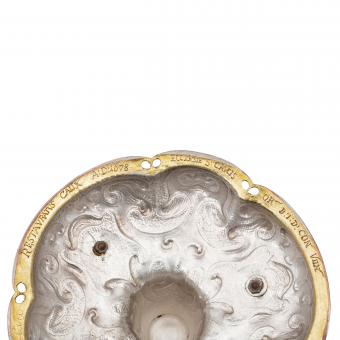
Vilnius (?), middle of the 17th c., restored 1678, 18th c.
A delicately engraved inscription on the perimeter of the base indicates that the vessel was restored back in 1678, and used to belong to the Fate Bene Fratelli of the Church of the Holy Cross in Vilnius.


Vilnius, 1739–1746
The rococo stucco altars that are currently in the Church of the Holy Cross were created from 1751 to 1753 after the fires that devastated Vilnius in 1748 and 1749. They replaced the burnt wooden retables with painted illusory decorations that had been put in place after the fire of 1737. At this time, the interior of the Church of the Holy Cross was being renewed from the ground up. It is likely that the carvings of the wooden altars made during this renovation are the ones that have survived, since the ornament style points to this period. The wings decorated with cutwork carvings had relics of the saints mounted inside them. Although small, the fragments of wooden altars from the first half of the 18th century are very valuable, because due to constant fires and decades of Russian repression, there are barely any wooden fittings left in the churches of Vilnius.

1610
Ordo Visitationis Beatissimae Mariae Virginis / The Order of the Visitation of the Blessed Virgin Mary
St Francis of Sales (1567–1622) united the first sisters who were led by the noble widow St Jane Frances de Chantal (1572–1641). Initially, they were determined to visit and take care of the poor and the sick, but soon strictly distanced themselves from the world, and the main mission of the Visitation nuns became teaching and bringing up girls.
The Visitation nuns were invited to Vilnius and their convent was generously endowed by a resident of Vilnius, a wealthy widow, Anna Warzkietówna-Karasiowa-Dezelsztowa, whose daughter entered a novitiate of the Visitation nuns in Warsaw. In 1694 the foundation of the new convent in Vilnius was laid, and the nuns settled there in 1698. In 1729, construction of the brick Church of the Most Sacred Heart of Jesus and St Francis de Sales began, and was consecrated in 1752. The convent in Vilnius was probably the largest and most important institution for the education for girls of noble families in all of Lithuania during the 18th and 19th centuries. After the uprising of 1863, the convent was suppressed citing the pernicious and uncontrollable influence of the sisters on the girls, and their secret contacts with the rebels. The Visitation nuns in France procured for their sisters in Vilnius, permission to go abroad without the right to return to the Russian Empire. In 1865, the last public service was held in the Church of the Most Sacred Heart of Jesus before it was given over to the Eastern Orthodox Church. The convent was given over to Eastern Orthodox nuns. The Visitation nuns returned to Vilnius in 1919, but were deprived of their convent by Soviet and Nazi authorities, and so they moved to Poland after World War II. The Soviet authorities used the residence of the Visitation nuns in Vilnius as a prison.

6th c.
Ordo Sancti Benedicti / The Order of St Benedict
St Benedict (6th century) paved the way for Western Christian monastic life. The day-to-day of societies that practice contemplative life is founded upon the Liturgy of the Hours prayers (opus divinum), private spiritual reading (lectio divina) and manual labour. Benedictine nun monasteries were first founded by St Scholastica, who was the sister of St Benedict.
It was Duke Mikołaj Krzysztof “the Orphan” Radziwiłł who invited the first Benedictine sisters to Lithuania from Chełmno, Poland, and in 1591 founded a Benedictine monastery in Nesvizh, (Belarus). During the first half of the 17th century, sisters from Nesvizh were sent to the convents in Kaunas, Minsk, Smolensk and Orsha. The first Benedictine sisters arrived in Vilnius around 1620 following an invitation from Vilnius residents, Mikołaj Horodyski and his wife Katarzyna. Soon the Vilnius community significantly grew in size – in 1622, twelve more sisters arrived from Nesvizh. For much of the 17th century, the sisters endured financial difficulties but in 1688, Feliks Jan Pac, donated a large estate to the Benedictine sisters which significantly changed the conditions of life for the Benedictine community. During the 18th century, the Vilnius Benedictines began to thrive. The situation worsened again in the 19th century and life grew more difficult for the nuns at the Vilnius convent. Later it went on to remain the only women’s convent open in Vilnius, which also became a refuge for the sisters of other Orders. By 1905, only six elderly Benedictine sisters remained when the Decree of Religious Tolerance was announced by the Russian Emperor, Nicholas II. As the conditions changed, the Convent of St Catherine was revived, and before the war, 31 sisters lived there. In the years of World War II, the sisters hid Jews in the Vilnius convent, which is why, together with the communities of other Vilnius convents, they were arrested, and later released. In 1944, the Benedictine community returned to their home, but in 1948, the Church and Convent of St Catherine was closed and converted into storage space, and the sisters were evicted from the convent. In 1964, the Vilnius Benedictines bought a house in Žvėrynas, and began to practice communal life again. They still live there to this day.


Vilnius, 17th c., 2nd half of the 18th c.
The reliquaries of the founder of the Benedictine monastery and creator of the rule St Benedict together with the patron saint of Lithuania, St Casimir are composed of elements from different eras. The large glass reliquaries in the centre are richly decorated with characteristic 18th century floral compositions made of paper strips. The medallions with the relics of the saints placed between these decorations also come from different periods: the medallion of St Benedict is clearly older, harkening back to the baroque era, while St Casimir’s piece is newer, dating from the 19th or early 20th century.


Lithuania, Europe, late 18th c. – early 20th c.
The crown was used in solemn ceremonies, when a novice would profess their eternal vows. The ceremony would begin with Holy Mass and Communion after which the novice would read the text of the vows from a sheet before handing it over to the priest, who would lay it down on the altar. The priest would then solemnly bless a new habit, and the abbess, along with the other nuns, would take the novice's white veil off her head and put on the newly blessed habit. The priest presiding over the ceremony would then place a new veil and a crown on the nun’s head and from that moment onwards, the novice would become a Benedictine nun and a bride of Christ.


Lithuania, 18th c. (?), Vilnius, 3 – 4 decades of the 20th c.
The crozier was commissioned by the last Vilnius abbess, Julija Anzelma Miličiūtė, but there is reason to believe that elements of a previous work were used to create it: the shape of the leaves is akin to the baroque, there are marks of the lamb figurine having been reattached, and one baroque-style flower-shaped screw remains in the crown. Several portraits of Vilnius Benedictines have been preserved, in which they are depicted with pastoral staffs (croziers), the tops of which are shaped like laurel wreaths with the Lamb in the centre.

